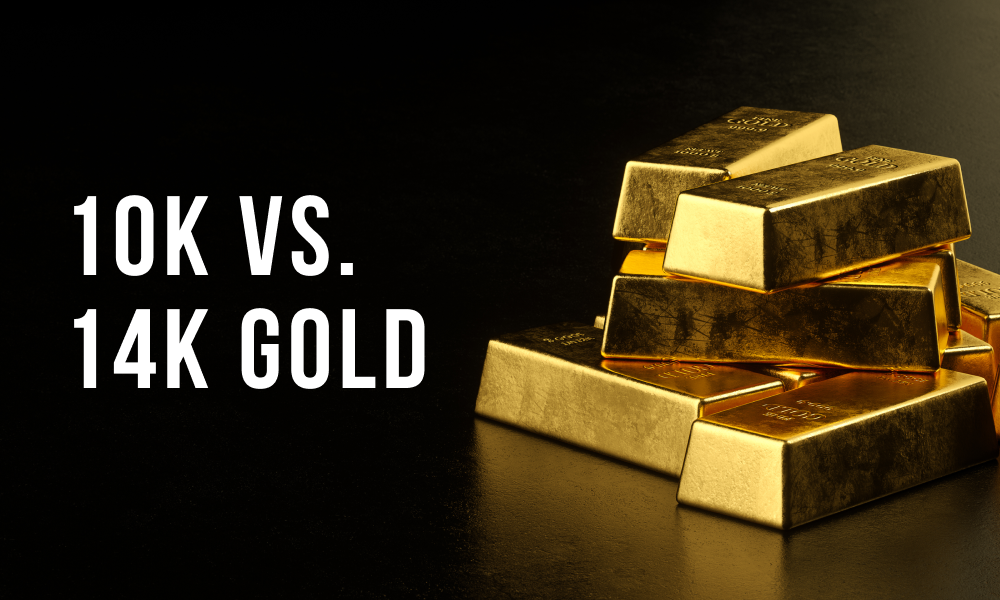
Gold is regarded as one of the most precious metals utilized in the creation of jewelry, celebrated for its visual appeal and resilience. Nevertheless, it is important to note that not all gold possesses the same quality. Certain items are composed of lower-karat gold (10K or 14K), while others are fashioned from higher-purity gold alloys (18K or 22K). Consequently, what factors should you consider when deciding between 14K and 18K gold?
The alloys of 14K and 18K gold are widely regarded as some of the most favored choices in the realm of jewelry. Each type of gold possesses distinct characteristics that merit consideration during the selection process. This guide aims to elucidate the differences, advantages, and disadvantages of both 14K and 18K gold, assisting you in making an informed decision regarding the most suitable option for your jewelry needs.
What are 14k Gold Alloys
A 14K gold alloy consists of 14 parts pure gold combined with 10 parts of various metals, including aluminum, silver, zinc, copper, and nickel. This composition results in a purity level of 58.3%, while the remaining 41.7% is made up of these additional alloys.
Due to its ideal combination of purity and strength, 14K gold has become the preferred choice for jewelry making. It provides an excellent balance that suits both everyday wear and more formal occasions, making it a versatile option for a wide range of jewelry designs.
What are 18k Gold Alloys
An 18K gold alloy is composed of 18 parts pure gold and 6 parts various metals, such as copper, zinc, nickel, silver, and aluminum. This results in a purity level of 75%, with the remaining percentage consisting of these additional alloys.
While 18K gold is softer and less resilient compared to higher karat gold, it possesses enhanced hypoallergenic qualities, making it an excellent choice for those with sensitive skin. This type of gold is especially favored by jewelry collectors who seek higher-purity pieces that tend to have greater resale value.

When distinguishing between 14K and 18K gold, it is essential to consider several important factors that allow us to differentiate between the two.
Purity
The primary distinction between 14K and 18K gold lies in the purity of the gold alloy:
- 14K Gold: 58.3% pure gold and 41.7% other metals.
- 18K Gold: 75% pure gold and 25% other metals.
Color
The quantity of gold present in a gold alloy determines its aesthetic properties:
- 14K Gold: Has a warmer but less saturated yellow color.
- 18K Gold: Characterized by a deeper yellow color, closer to the color of pure 24K gold.
Durability
The proportion of gold present in the alloy significantly influences its strength and durability:
- 14K Gold: Stronger and more durable due to the higher content of other metals, providing enhanced scratch resistance.
- 18K Gold: Softer and less durable, more prone to scratches and dents, but less reactive to chemicals.
Price
The cost of gold jewelry is determined by the gold's purity level:
- 14K Gold: More affordable due to lower gold content.
- 18K Gold: More expensive due to higher gold content.
Resale Value
Assessing the resale value of gold jewelry is essential for informed decision-making:
- 14K Gold: Generally lower resale value but can be increased with the addition of embellishments or precious gemstones.
- 18K Gold: Higher resale value due to higher purity, also enhanced by exclusive attributes or gemstones.
Types of Jewelry Made of 14k and 18k Gold

14k Gold Jewelry
- Chains: Durable and perfect for everyday wear.
- Rings: Popular for wedding and engagement rings , offering a good balance of durability and beauty.
- Bracelets: Strong enough to withstand daily use, ideal for both casual and formal settings.
- Earrings: Affordable and versatile, making them a great choice for various styles and occasions.
18k Gold Jewelry
- Chains: Luxurious and ideal for special occasions, showcasing a richer color and higher gold content.
- Rings: Higher purity makes them more valuable and desirable for fine jewelry.
- Bracelets: Softer and better suited for occasional wear or special events.
- Earrings: Hypoallergenic, making them great for sensitive skin while offering a sophisticated look.
Pros and Cons
14k Gold
The advantages and disadvantages of 14k gold are as follows:
Advantages
- More durable and scratch-resistant .
- More affordable.
- Versatile for various types of jewelry.
Disadvantages:
- Less pure than 18K gold.
- Less vibrant yellow color.
18k Gold
The advantages and disadvantages of 18k gold are outlined as follows:
Advantages
- Higher purity and richer color.
- Higher resale value.
- Better hypoallergenic properties.
Disadvantages:
- Softer and less durable.
- More expensive.
Choosing Between 14k and 18k Gold

When selecting between 14K and 18K gold, it is important to take the following factors into account.
- Budget: 14K gold is more affordable, while 18K gold is more expensive.
- Durability: 14K gold is stronger and more durable, making it suitable for daily wear. 18K gold is softer and better for occasional wear.
- Color Preference: 14K gold has a warm, less saturated yellow, while 18K gold has a deeper, richer yellow.
- Skin Sensitivity: 18K gold is more hypoallergenic and better for sensitive skin.
- Resale Value: 18K gold has a higher resale value due to its higher purity.
The Ultimate Guide to Gold Jewelry
Gold jewelry is available in various styles, with both 14K and 18K gold being utilized to craft an extensive range of items. This discussion will provide an in-depth examination of several well-known categories of gold jewelry and the influence of karat weight on their properties.
Necklaces
- 14K Gold Necklaces: Ideal for everyday wear due to their durability. They can withstand daily activities and still maintain their appearance.
- 18K Gold Necklaces: Perfect for special occasions. Their richer color and higher gold content make them stand out, but they require more care to avoid scratches.
Bracelets
- 14K Gold Bracelets: Strong and resistant to wear and tear. Great for casual and formal wear.
- 18K Gold Bracelets: Softer and more delicate. Best reserved for special occasions or less active settings.
Rings
- 14K Gold Rings: Commonly used for engagement and wedding rings. They offer a good balance of beauty and durability.
- 18K Gold Rings: More luxurious and often used for high-end jewelry pieces. Their higher purity and richer color make them highly desirable, but they are more susceptible to scratches.
Earrings
- 14K Gold Earrings: Affordable and versatile, suitable for a wide range of styles and occasions.
- 18K Gold Earrings: Hypoallergenic and ideal for those with sensitive skin. Their higher purity provides a luxurious appearance.
Understanding the Market Value

The market price of gold jewelry is subject to change in accordance with prevailing gold prices. When acquiring gold jewelry, it is essential to take into account the market value of gold and its influence on the pricing of 14K and 18K gold items.
- 14K Gold: Lower market value due to lower gold content. More affordable for those looking to buy gold jewelry on a budget.
- 18K Gold: Higher market value due to higher gold content. More expensive but can be a better investment in the long run.
Customizing Your Gold Jewelry
One of the benefits of gold jewelry is the opportunity for customization to align with your individual style and tastes. Regardless of whether you choose 14K or 18K gold, you have the ability to design distinctive items that embody your character.
- Engravings: Add a personal touch to your gold jewelry with custom engravings.
- Gemstones: Enhance the beauty of your gold jewelry with the addition of precious gemstones.
- Designs: Work with a jeweler to create custom designs that are tailored to your taste.
For those seeking high-quality custom gold jewelry, Ucciyo's customized jewelry service stands out as an excellent choice. Our experienced jewelers are capable of transforming any design you envision into a stunning reality.
Care and Maintenance
To ensure that your gold jewelry remains in optimal condition, it is crucial to provide proper care and maintenance. Below are several recommendations for preserving the appearance of both 14K and 18K gold jewelry.
- Regular Cleaning: Clean your gold jewelry regularly to remove dirt and oils that can dull its appearance.
- Avoid Harsh Chemicals: Keep your gold jewelry away from harsh chemicals that can damage the metal.
- Proper Storage: Store your gold jewelry in a soft cloth or jewelry box to prevent scratches and tarnishing.
Conclusion
Grasping the distinctions between 14K and 18K gold is crucial when choosing the most suitable gold type for your jewelry. It is important to evaluate factors such as purity, hue, resilience, cost, and potential resale value of each gold type to ensure a well-informed choice. Additionally, reflect on your individual style, preferences, financial considerations, and expectations to ascertain which gold type aligns best with your needs.
Should you opt for 14K or 18K gold jewelry, we invite you to browse IceCartel’s exclusive collection, featuring high-quality items and outstanding designs. Wishing you a pleasant shopping experience!






